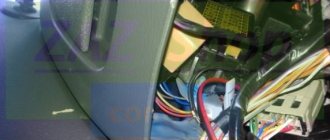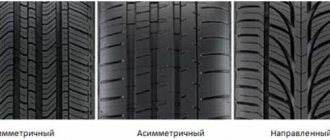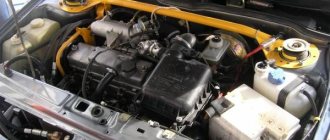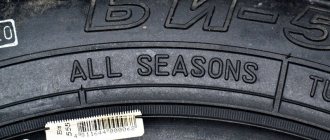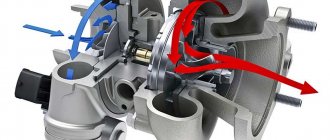In recent years, tire shops have been trying to popularize a new service - filling car tires with nitrogen instead of regular air. This topic is overgrown with many fables and myths, as sellers endow “nitrogen” rays with fictitious advantages, and opponents put forward theories that have not been tested in practice. Why inflate wheels with pure nitrogen and what real benefits the driver receives, read in this publication.
Price issue
When you arrive at a tire shop and succumb to persuasion to fill your tires with nitrogen, you will see that the air from your car’s tires will first be pumped out and then filled with nitrogen from a special installation. The pressure will be set according to the technical requirements of the vehicle manufacturer. This procedure will cost from 180 to 260 rubles per wheel. The larger the diameter, the more expensive.
The maximum possible amount of air is removed from the wheel cavity. But, please note, not all air!
The maximum possible amount of air is removed from the wheel cavity. But, please note, not all air!
Special, expensive equipment for nitrogen injection.
Special, expensive equipment for nitrogen injection.
History of the use of nitrogen injection technology
Inflating tires with nitrogen is one of those cases when technology comes to our region with extreme delay. It seems that we have known about this method of refilling tires for a long time, but you won’t find a developed infrastructure with the proper level of service, especially in cities with a population of less than a million. As a rule, "nitrogen stations" are located in large commercial workshops and primarily service premium and sports cars. Around 2012, active development of this technology began, and since then, nitrogen tanks can now be found at many service stations, gas stations and other large transport facilities.
We recommend: Purpose, design and specifics of operation of an automobile driveline
For the first time, this technique was used during the races of the most famous automobile competition - Formula 1. Taking advantage of a loophole in the tournament regulations, one of the teams used nitrogen to fill the tires of their car.
For the first time, nitrogen was used to inflate wheels in Formula 1 cars.
Although, it should be noted and added that at that time nitrogen of such purity was not yet available in mass industry. Instead, a nitrogen-air mixture was used. But even the use of such a mix brought popularity to nitrogen filling, and to the mixture itself general interest from other companies and firms.
Advertising stunt
At a branded expensive tire service, almost any car owner, and especially the owner, will probably be offered to inflate their tires with nitrogen. There are a lot of arguments in favor of this procedure. Let's figure out which of them are true and which are fiction:
- The tire pressure will be stable because nitrogen hardly expands when heated.
But the air already contains 78% nitrogen, so the changes account for the rest of the gases, which also do not expand beyond measure. The difference in the coefficient of volumetric expansion is negligible with a significant figure in the fourth decimal place. - Nitrogen molecules are larger and therefore do not penetrate outward through the tire walls as quickly, keeping the pressure stable.
But do not forget that there is not so much oxygen with other gases - about 22%. And when they begin to evaporate, and we begin to pump up the tire, the nitrogen concentration will increase. So, a 5-6-year-old wheel develops an almost purely nitrogen “atmosphere” inside. - A wheel filled with nitrogen is lighter than a wheel inflated with atmospheric air.
This saves fuel. Simple calculations show that the wheel of a mid-size crossover will be lighter by only a few grams. How much do the pebbles stuck in the tread weigh? Let's clean the tread more often, especially since tire design engineers highly recommend it. - The absence of oxygen protects the tire material from premature aging.
Tire manufacturers support this thesis, but you don’t hope that after a century your tires will be located on a pedestal, like the wheels of Lenin’s armored car. Wear and aging of the outer layers of rubber under the influence of the sun, ozone, and moisture occurs much faster. - Better road grip and greater safety due to stable performance.
I don’t agree: you still need to check the tire pressure periodically, and with each “puff” precious nitrogen will be released. And you can’t let yourself down. This is how servicemen strive to tie a car enthusiast to their workshop even for such an insignificant problem as checking pressure and inflating a tire.
When checking the tire pressure, some of the gas inevitably escapes. It is possible to replenish lost nitrogen only with the help of specialized equipment.
When checking the tire pressure, some of the gas inevitably escapes. It is possible to replenish lost nitrogen only with the help of specialized equipment.
Nitrogen tire inflation and its disadvantages
Apart from the inflated price tag, there is no shortage of nitrogen injection into tires. However, as well as advantages. Advantages such as “less tire weight with nitrogen” are manifested in 7-10 grams in each wheel. In Formula 1, perhaps this indicator is significant, since everything is measured there to the utmost precision, and every gram is worth its weight in gold. But is this quality important for daily commuting? You need to answer this question yourself.
And these were just the main myths that we discussed in our article. There are materials that discuss other parameters, but we have already brought you to the conclusion that inflating tires with nitrogen is a completely useless exercise. It will only help in that it will bring additional profit to the service where this service is offered to you.
Does nitrogen really extend tire life?
Advertisers claim that the inside of the tire must be protected from dangerous oxygen and only nitrogen can cope with this. It sounds nice, but what about the air that is outside? What about reagents and sunlight? If you find the first old tire you come across in a landfill, it will be obvious that the destruction is not happening from the inside, but from the outside. Accordingly, nitrogen does not protect it in any way.
Healthy! Perhaps the only true statement is that corrosion inside the disc develops faster under the influence of more oxygen. But, alas, if it forms on the outside, it will still lead to the destruction of the rubber.
If you still have doubts about whether it’s worth inflating your tires with nitrogen, let’s consider the rest of the myths that sellers make up about this gas.
Conclusion
You should only pump nitrogen into tires after weighing all the positive and negative aspects of this procedure. In practice, the use of nitrogen is a very profitable business, since profits come literally out of thin air. Of course, you can personally test the effect of swapping, comparing it with existing experience and without delving into theoretical explanations. We just want to note that there will be no harm from this procedure, but you shouldn’t expect significant changes.
In conclusion, it should be clarified that injecting nitrogen into car tires for passenger vehicles does not make much sense. In fact, the car owner will see absolutely no difference. In commercial vehicles, especially on special vehicles - fuel tankers and other vehicles, the use of nitrogen makes much more sense. In this option, the costs of using a nitrogenous mixture are transferred to the carrier company, and an insignificant increase in safety is achieved in some conditions. Although, the difference in this case will be insignificant in real conditions.
Car wheel
Well, of course, the motorist himself will make the decision!
Analysis of the situation with argumentation
p, blockquote 28,0,0,0,0 —>
So, we figured out that the advertising slogans of car services that provide nitrogen tire inflation services have nothing to do with the real advantages.
p, blockquote 29,0,0,0,0 —>
We also analyzed that even in the conditions of sports tracks, the advantages of using this gas are insignificant or completely absent.
p, blockquote 30,0,0,0,0 —>
And if you look at this source of information about car tires and wheels, you will find there other arguments that there is no point in spending extra money on nitrogen.
Based on this, we can unequivocally say that the use of nitrogen in passenger car tires is pointless and, in fact, represents a drain on extra money for a far-fetched service.
STEP 2 – Check pressure less frequently
Stability of tire pressure (you can look at them less often). The second misconception is that nitrogen molecules are larger than oxygen molecules. That supposedly they are more difficult to pass through microcracks, and therefore tires can be inflated less often. But guys, these are molecules, their volumes are so small!!! The size of a nitrogen molecule = 0.000000031 cm (3.1X10 -8 degrees), but the oxygen molecules are 0.000000029 cm (2.9X10 -8 degrees), the difference is not significant. About 6%, so if there is a puncture, the tire will deflate equally, regardless of what it is inflated with.
YES, and if you look at modern tubeless tires, manufacturers have made such progress that they can hold pressure for years! Even if there is a puncture, it will not deflate so quickly, but will let you get to the TIRE WORKSHOP, EVEN IF THERE IS REGULAR AIR INSIDE.
Motion stability
Every driver knows that in the cold season, when a car is moving from a parking lot, its “behavior” will be very different from how it will behave when the engine and tires are warm. This happens because when the tires rub against the asphalt, they heat up, causing the pressure to change.
In workshops where they offer to pump nitrogen into tires, experts claim that the pressure will always be constant, due to the absence of oxygen. In their opinion, this will allow the car to always behave the same.
But if we turn to the laws of physics, namely, Charles’s law and Gay-Lussac’s law, we can conclude that the gas pressure in the tire will increase in any case when warming up.
Bottom line: It makes no difference whether you use air or nitrogen, the pressure will “jump” in any case.
Reduced fuel consumption
This is one of the most common reasons for using nitrogen instead of air. Its essence boils down to the fact that the specified gas is lighter than air, and accordingly, less weight of the wheel will lead to lower fuel consumption.
To do this, you need to understand the real numbers. A cubic meter of air that is pumped into tires weighs 1.29 kg, and a cubic meter of gas weighs 1.25 kg. A standard passenger car wheel holds about 75 grams of pure gas and 77 grams of air mixture. Therefore, the difference between fully inflated wheels will be a few grams, which is negligible for significant fuel savings.
The difference is almost unnoticeable - dirt between the treads or pebbles add much more weight to the wheel.
Long tire life and reduced wheel corrosion
Perhaps this is one of the points that can really be substantiated. Proponents of nitrogen claim that when it is used instead of air, the disc does not rust inside, and the rubber itself is consumed less actively. Since oxygen is one of the main catalysts for oxidation, in its absence there is less chance of rust occurring inside the wheel. However, this plus is questionable, since the outside of the wheel is still exposed to oxygen and even a more aggressive environment - dirt, snow, rain, dust, and so on.
Please note: Modern disks “age” for a very long time, since they are made of an alloy of aluminum and magnesium.
Bottom line: When pumping nitrogen, you can keep the disk new on the inside, but rusty on the outside.
( 284 votes, average: 4.45 out of 5)
Rolling of stamped discs
Why does the car pull to the left or right after changing tires?
Related Posts
I have a punctured tire - how can I fix the puncture myself using a tourniquet?
In fact, despite its long-standing prevalence, for many car enthusiasts the very sight of a nail or self-tapping screw being pulled out of the wheel of their car, and then, instead of carefully patching the damage, they enlarge it even more with a thick file is quite a novelty. The first time you see a tire puncture repaired with a harness, it evokes a feeling of amazement and doubt. You're surprised that it will keep the air inside the wheel sealed and question whether it will last longer than a day or two. But the fact is that this method of repairing a tire is much more effective than repairing it with a patch and, most likely, this harness will outlive the tire itself.
But repairing a tire with a tourniquet has another very significant advantage - the ability to repair a puncture yourself with a tourniquet. This is why you should definitely purchase a tire repair kit to repair the tread on one of your tires. With the help of a small fork-shaped awl you can give new life to a punctured tire.
Advantages of the method
Inflating tires with nitrogen has both supporters and opponents. Moreover, they are present among professionals, including owners of tire stations and service stations, and among amateurs. The advantages of the method include:
- no gas leakage - wheels flatten less;
- reduced wheel weight - lower fuel consumption;
- no tire overheating;
- increased security;
- stable tire pressure;
- slowing down the aging of rubber wheel elements;
Process technology
Nitrogen generator
It is known from a school chemistry course that the composition of air includes the following components:
- 78% nitrogen;
- 20% oxygen;
- 2% carbon dioxide and various impurities.
Tires are filled with nitrogen using special equipment - a nitrogen generator. This device allows you to obtain a mixture consisting of 95% nitrogen from air. Before inflating the rubber, air is supplied to the generator at a pressure of 8 atm. Then it is filtered in several stages, various impurities are removed from it, and humidity is reduced. The purified air mixture, entering the filter membranes, loses nitrogen molecules. The output is an almost pure (without impurities) nitrogen mixture.
Inflating tires with a nitrogen mixture is widespread in European countries. This procedure is often used for racing cars and commercial vehicles, as well as buses. Manufacturers of nitrogen mixture generators, together with many service station owners, often offer this service, pointing out the benefits that the car owner will ultimately receive. Under the influence of advertising, most motorists are trying to experience in practice the benefits of pumping nitrogen into tires. At the same time, in order to inflate the wheels with the specified gas, you need to spend a lot of money. The question arises: “Isn’t the advertised procedure a dubious service that does not bring much benefit to the driver?”
We recommend watching a video about inflating tires with a nitrogen mixture:
Video: nitrogen or air, which is better?
- Author: Alexander
Rate this article:
- 5
- 4
- 3
- 2
- 1
(5 votes, average: 3 out of 5)
Share with your friends!
Why do you need an oil pressure light and what to do if it lights up while the engine is running
Stickerbombing: history, features and types
